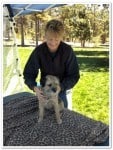Q: How can practitioners of alternative therapies get referrals from veterinarians? What can someone just starting out do to develop a relationship with a veterinarian (that will hopefully lead to referrals)?
Building relationships and collaboration are important parts of any successful business, and when your business is complementary animal health, building those relationships with veterinarians and other animal health professionals in your area can really make a difference.
In our previous post about working with Veterinarians – Should Alternative Practitioners Ask for Veterinary Consent? – our experts shared their views on that subject, and today, they will give us more tips on developing these important relationships and how to get referrals from veterinarians.
 Theresa Gagnon Mending Fences Animal Wellness:
Theresa Gagnon Mending Fences Animal Wellness:
Obtaining referrals from veterinarians can be difficult. I start by going into the office and introducing myself. You may not get directly to the veterinarian because of their busy schedule, but you can leave information with the staff and possibly make an appointment to see the vet. Be prepared by having brochures, business cards, an introductory letter, and possibly a resume or list of credentials. If you are working with an animal recovering from an injury or surgery, make sure that your client shares your successes with their veterinarian. Perhaps you could accompany your client to the vet’s office for a follow up with a small animal or try to be at the barn when the vet comes for a horse. Veterinarians need to get to know you and be confident in your reputation before they will refer you.
 Beth Innis, DVM, Sleepy Dog Acupuncture:
Beth Innis, DVM, Sleepy Dog Acupuncture:
To get referrals / work with a veterinarian – honestly, in veterinary medicine, I think word of mouth is huge. I would think the best bet might be to connect with a veterinary acupuncturist, herbalist, homeopath, chiropractor, physical therapist – these are practices that tend to be open to other alternative healing modalities and would likely have clients that would be interested.
Be clear about the extent of your training, making sure we know where and when and how you trained, and tell us how you intend to fit into the treatment of the animal. It is so important to have good communication with the pet’s veterinarian – send frequent updates even if you were not referred that pet directly as that will help to show your competence, communication and follow up.
 Lisa Ruthig, Bancroft School of Massage Therapy/Doggone U
Lisa Ruthig, Bancroft School of Massage Therapy/Doggone U
It is important to realize that veterinarians stake their reputations on the practitioners to whom they refer. Therefore, you need to be able to show results, and prove to the vet you will be worthwhile to their patients. Case studies, testimonials, and a proven track record will be valuable. Presenting the vet with a professional referral package can be a good idea. Use a short introductory letter telling about your qualifications, heavily weighted toward how you can help the vet help his or her patients. You could include a referral book that the vet can use to write a “prescription” for the number and frequency of sessions, and any contraindications. Be sure to find out from the vet what sort of communication is expected from you: reports each session or a summary at completion, and follow up as requested.
Cold calling veterinarians isn’t terribly fruitful. Approach people with whom you already have some type of relationship. If you have a client with an issue that should have veterinary approval, ask for permission to talk to the vet directly, and send them a report, so they get to know you.
Keep in mind that the doctor/ massage practitioner relationship is a little more fraught in the animal world than in the human world. Some vets are worried about competition, and some are worried about the safety of our patients in our care. Others are skeptical about the efficacy of massage. I assure veterinarians that I encourage my clients to see their vets more often than they might normally because of my findings (skin issues, lumps, musculoskeletal issues). Remember that diagnosing injury or illness, treating it, and giving a prognosis are all out of our scope of practice, and it’s important to get a diagnosis from a vet before working on acute injuries. If your client tells your vet that the massage therapist has been giving them advice that runs counter to their own, it won’t help you build a relationship with that vet, and could be a danger to all massage therapists in your state if they make a complaint.
To convince them of the efficacy of massage, the “lunch-n-learn” model could be useful, where you buy the staff lunch and give a presentation on the uses of massage. This is the place for case studies, not a list of massage benefits. Prove to the vet, and, just as importantly, her techs and assistants, who might also give out your card, that massage will help them give the best quality of care to their patients, and is worth the risk to their reputations. Ask to give a demo on an animal belonging to one of the clinic staff.
Veterinary referrals can be a great way to build your business. Once you have some experience and good results under your belt, don’t be afraid to share that with vets, to the benefit of the vet’s patients, his practice, and your business.
 Amy Snow, Tallgrass Animal Acupressure Institute:
Amy Snow, Tallgrass Animal Acupressure Institute:
1. Make an effort to go to your local veterinarians and simply talk with them to learn more about their practice. Ask if s/he has chronic cases where it might be good for the animal to receive other supportive care such as an animal with arthritis or just aging issues. Explain what you can do to help the animal with acupressure-massage and what your scope of service is. Be very careful to be clear about your limitations as well as the benefits of these modalities.
2. Show the vet your referral form and ask if s/he sees ways to improve it.
3. Ask if s/he would like you to work with one of his animal – offer 2 sessions.
4. Gently mention you are putting together a referral list for your clients and ask if it would be okay to list her/his clinic?
5. Be sure to mention if you are involved in any animal organizations – you could be a source of networking for the clinic.
6. The higher the visibility you have in the animal community, the better for connecting with vets. Do what you have to do to build your clientele no matter what – demos, talks, write articles and blogs, connect with local news outlets, etc. Build your community profile.
 Cattie Coyle, Animal Wellness Guide
Cattie Coyle, Animal Wellness Guide
If the course you are taking has an internship as part of the program, try to do it at a veterinary clinic. When I was in the small animal massage program at Bancroft, that’s what I did, and after the veterinarians there saw the results massage had on their patients, and got great feedback from their clients, they were happy to let me display brochures in their waiting room and started giving people my name. And I had a few clients who asked me to keep working with their dogs after the internship ended.
 Lola Michelin, Northwest School of Animal Massage:
Lola Michelin, Northwest School of Animal Massage:
Referral relationships can be one of the most valuable aspects of your animal massage practice. Veterinarian are the first group of health care providers that come to mind in terms of referral relationships, but practitioners should also consider trainers, groomers, other specialized health care providers, as well as other massage practitioners as potential referral relationships. In my experience, you don’t need many of these types of relationships…you need a few good ones and then you need to pay extra attention to maintaining them.
When I moved my practice from the east coast to the Pacific Northwest, I developed relationships with two veterinarians and one horse trainer. They accounted for about 80% of my clients while I was building my practice. Eighteen years later, I still work closely with two of them.
Referral relationships take more intention and nurturing than a networking relationship, so I recommend to our students that they do their research first. Who are the practitioners in your area and what is their reputation or specializations? Would you use them to treat your own pets? Do they offer something compatible with your services such as chiropractic or rehabilitation services? Give yourself 3-5 individuals or practices that you want to explore a relationship with and approach them professionally… no space for cold calling here. Get a warm introduction from an existing client or book a time to sit down with them and introduce yourself. In many cases, asking to shadow them during a workday helps them get to know you and gives you an opportunity to view their work as well. If it is a natural fit, a day spent together will let you both know if you want to continue the relationship.
I find that getting the relationship off the ground is actually the easier part…maintaining the goodwill and living up to your end of the bargain by bringing your best to every session is the more important aspect.